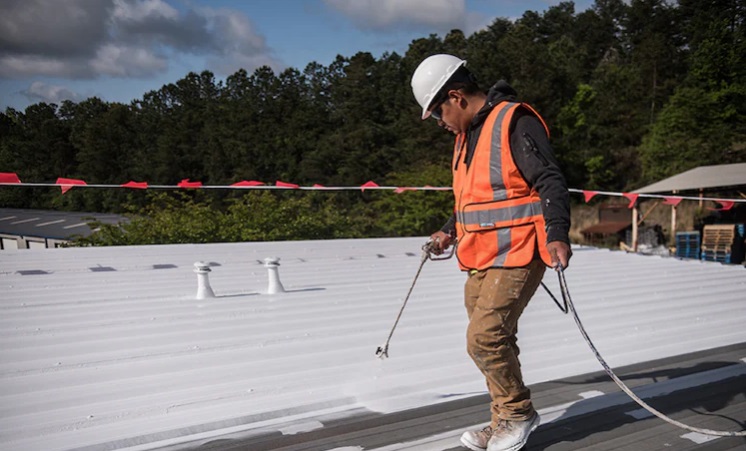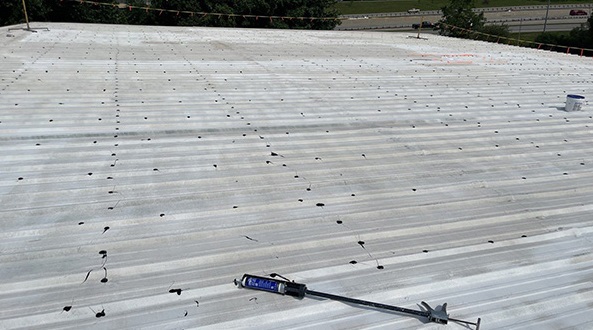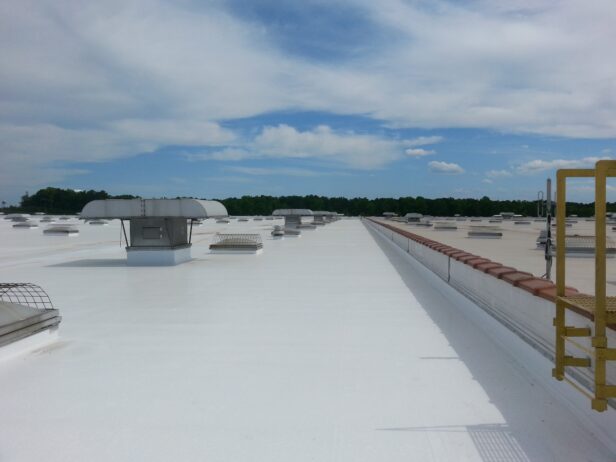If you have a metal roof with issues, such as leaks, rust, etc., you’re in the right place.
In this article, we’ll discuss:
- Why do metal roof building owners choose silicone coatings?
- What is the cost per square foot?
- What is a sample “scope of work”?
- What other “out of the box” things should owners look out for?
Alpha Commercial Roofing is a commercial roofing contractor in Alpharetta, GA. We’ve been restoring metal roofs for 12 plus years. Usually, this is done with the spray foam roofing system, but on some occasions, a silicone roof coating system will be a more cost-effective option.
Why do metal roof building owners choose silicone coatings?
- Ripping off and replacing a metal roof is crazy expensive and disruptive to business operations.
- A coating system is fluid-applied, meaning it’ll 100% cover all fasteners, seams, and screws that may be allowing water to enter. It’ll also cover any pinholes or microscopic openings in the metal.
- Silicone reflects UV rays, which reduces the roof temperature and will likely lower your energy bills.
- Coating systems give 10–20-year, renewable warranties. This makes forecasting the roof a predictable expense.

What is the cost per square foot?
Silicone roof coating systems, 99% of the time, cost $3.50 – $7 per square foot. Many variables influence the cost. The most severe ones are:
Warranty Length
The warranty length is always determined by the coating thickness.
- For a 10-year-warranty, a 20-mil thickness of coating is installed
- For a 15-year-warranty, a 25-mil thickness of coating is installed
- For a 20-year-warranty, a 30-mil thickness of coating is installed
A longer warranty requires more material, which adds to the cost of a project.
Metal Profile
Is your metal roof “low-ribbed” or “standing seam?” A deeper-seamed roof will cost more than the same sized roof that’s “lower-seamed.”
The reason is that when determining the square footage of a metal roof, you have to imagine that the roof is flat. As if the seams were pulled apart or stretched flat.
This is the only true way to determine an accurate square footage for proper coating coverage.
A few inches up and down every seam can add up to a lot of square feet over a 10-, 20-, 50,000 square foot roof.
Number of Fasteners or Nails
Different panels use a different amount of fasteners or nails. When installing a coating system, every single fastener or nail must be treated with additional sealants and coating before the field of the roof is installed.

Is a Rust Inhibitor Primer Needed?
A silicone coating system’s most important aspect is ensuring the adhesion between coating and metal is paramount.
In some cases, a primer must be used because the adhesion test failed.
If there’s rust, a rust inhibitor primer may be needed.
If a primer is needed, the cost will increase.
What is a sample “scope of work”?
- Inspection: An inspection is conducted to identify areas of concern, such as rust, loose fasteners, loose nails, seam damage, or anything that can affect the adhesion between metal and coating.
- Setup Warning Lines: Warning lines are set up around the work area to protect the crew and building occupants.
- Powerwash: The roof is powerwashed (PSI is set to manufacturer specs) to remove dirt, debris, and any other substance that could interfere with the proper adhesion of silicone coating.
- Adhesion Test: An adhesion test ensures perfect adhesion between coating and metal.
- Fastener Treatment: Existing fasteners are treated with self-leveling silicone sealant to provide an additional waterproof barrier. Any loose or missing fasteners, screws, or nails are replaced.
- Seam Treatment: All seams are treated with silicone mastic to prevent water infiltration and ensure a continuous waterproof barrier.
- Skylight Work: If the roof has skylights, they can be cleaned, covered up, removed, and/or properly sealed to ensure watertight integration with the new coating system.
- Masking of Rooftop Equipment: All HVAC units, exhausts, and pipes are masked to block coating from entering the building.
- Application of High Solids Silicone: The silicone coating is finally installed (via snake and rolling or through a spray gun) according to the manufacturer’s specifications to ensure optimal thickness, coverage, and warranty length.
- Cleanup: After applying the coating, all job-related debris and surplus material are removed from the site, leaving your roof looking clean and professional.
- Touchup and Warranty Issuance: A post-job inspection is conducted to identify thin coating or areas needing to be touched up. If the warranty goes through the coating manufacturer, one of their representatives will be on-site. Once completed, a warranty is issued.

What other “out of the box” things should owners look out for?
Here are some things to look out for:
- Brand of coating: Does the contractor specify the type of coating they are installing, or are they using some unidentified product?
- Detailed Scope of Work: Does the scope of work follow the manufacturer’s specifications for a proper installation?
- Precise Reference List: All contractors have perfect projects they like to market with. But do they have one similar to your project? For example, a silicone coating over an existing metal roof that’s roughly the same size as your building. Perhaps you can see that roof and get an idea of how the roof is holding up. Nothing portrays trust and confidence like seeing a similar roof after it’s been through the elements for multiple years.
- Warranty Length: If someone offers anything less than a 10-year warranty on a complete metal roof coating project, something probably isn’t right.
Conclusion
Silicone roof coatings are a smart investment for building owners looking to protect their metal roofs without the hassle and expense of a complete replacement.
Call Alpha Commercial Roofs today at 855-862-7663.





